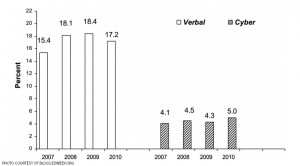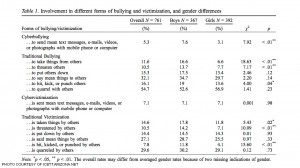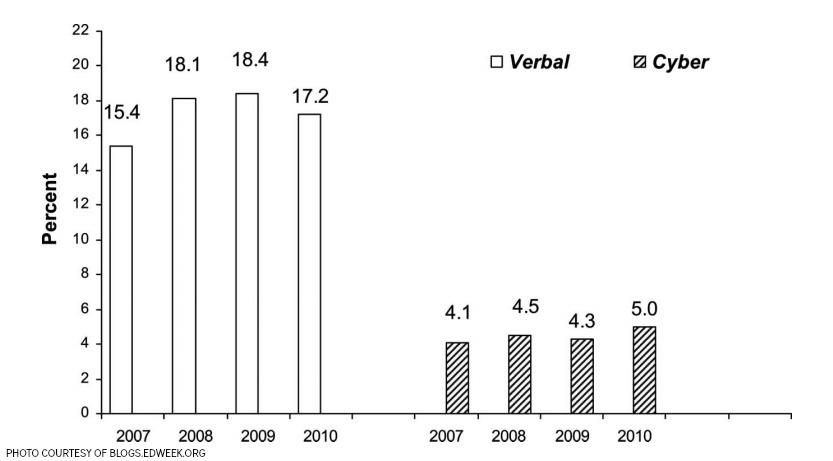
A recent study done by Dan Olweus, a psychologist at the University of Bergen, determined that statistics on cyberbullying are greatly exaggerated.
Unfortunately, these exaggerated statistics are commonly used by the media as well as different anti-bullying organizations.
After constantly hearing about cyberbullying in the media and news, Olweus began an in-depth study in order to uncover the truth about the prevalence of cyberbullying in modern society. Most of the research he conducted was large scale. One of his large-scaled studies looked at 450,490 US students in 1,349 schools in grades 3-12. Each of these large studies asked students about their experiences with traditional/verbal bullying, as well as cyberbullying. In order to avoid a misunderstanding of the term “bullying,” Olweus included the following definitions when inquiring the students:
“We say a student is being bullied when another student, or several other students:
– say mean and hurtful things or make fun of him or her or call him or her mean and hurtful names
– completely ignore or exclude him or her from their group of friends or leave him or her out of things on purpose
– hit, kick, push, shove around, or lock him or her inside a room
– tell lies or spread false rumours about him or her or send mean notes and try to make other students dislike him or her
– and other hurtful things like that.
When we talk about bullying, these things may happen repeatedly, and it is difficult for the student being bullied to defend himself or herself. We also call it bullying when a student is teased repeatedly in a mean and hurtful way. But we don’t call it bullying when the teasing is done in a friendly and playful way. Also, it is not bullying when two students of about the same strength or power, argue or fight.”

After years of tedious research on the topic, Olweus made final the observation that “cyberbullying is actually a quite low-prevalence phenomenon, representing only some 25 to 35% of the level of traditional bullying by direct verbal means.”
Olweus believes that society and the media make these exaggerated claims about cyberbullying because “cyberbullying has been studied ‘in isolation’… outside a general context of (traditional) bullying, and often also without a general student-friendly definition of what is meant by bullying.”
According to Olweus’ definition of the term, bullying is aggressive behavior that is intentional and involves an imbalance of power. Most often, it is repeated over time. It’s common for students to not fully understand what it means to be bullied, leading to a misconception of the idea.
As well as misleading the public, the exaggerated statistics may start to cause problems within society.
“Such a distorted portrayal of reality will probably generate a lot of unnecessary anxiety and tension among parents and maybe teachers and students. It may also create feelings of powerlessness and helplessness in the face of the presumably ‘huge’ and ubiquitous cyberbullying problem,” said Olweus in his discussion paper.
By exaggerating cyberbullying and its prevalence, the spotlight is taken away from what society as a whole needs to focus on, which is traditional bullying. In his research, Olweus discovered that the traditional form of bullying is almost three times as prevalent as cyberbullying. Unfortunately, due to the current hype and awareness surrounding cyberbullying, many of us fail to realize that traditional bullying still occurs on a daily basis.
Petra Gradinger, Dagmar Strohmeier, and Christiane Spiel, professors at the University of Vienna, conducted a study similar to Olweus’. Like Olweus, the three professors evaluated a large group of students they thought accurately represented the population. They asked the students about their involvement in both traditional bullying and cyberbullying. The results of their large study came back similar to the results of Olweus’. Cyberbullying and the involvement students had in it was far less prevalent than their involvement and experience with traditional bullying.
“According to the global item measurement, cyberbullying was reported much more rarely compared with bullying. While 48.8% of girls and 46.2% of boys reported being involved in bullying, only 6.7% of girls and 6% of boys reported being involved in cyberbullying at least one or two times during the last two months,” said the professors in their discussion paper.
Although traditional bullying statistics are dominating those of cyberbullying, it’s important that we aren’t misguided.
“I definitely think it is necessary and beneficial to place cyberbullying in proper context and to have a more realistic picture of its prevalence and nature. It is important also to take cyberbullying seriously both in research and intervention/prevention,” said Olweus in his discussion paper.
Even though cyberbullying is not as big of a problem as it’s made out to be, bullying is still an issue in society, no matter the form.

Leave a Reply